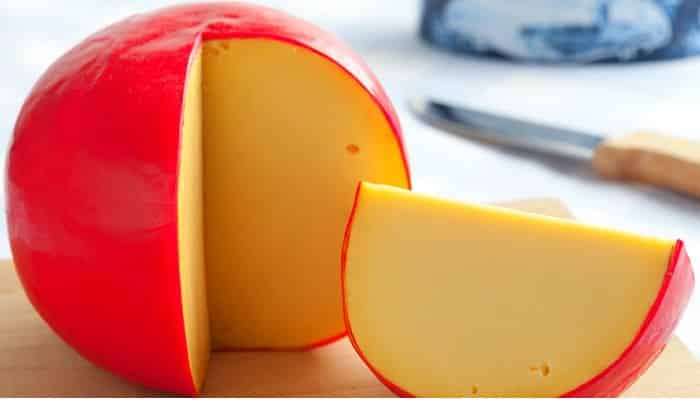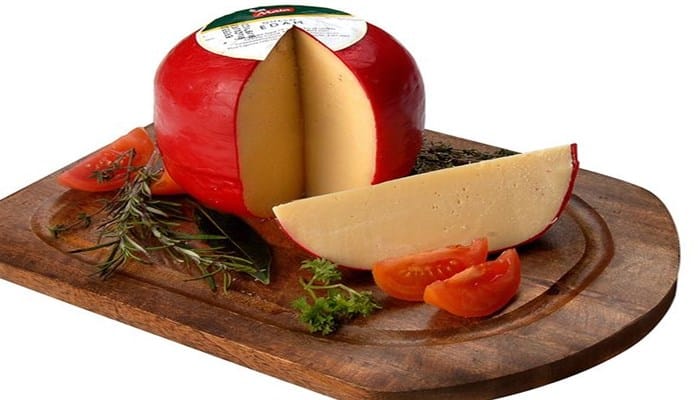What is Queso de Bola? The Perfect Blend of Dutch and Filipino Cultures

There is a certain sphere of golden deliciousness that has been gracing festive tables in the Philippines for generations. This delectable delight, known as Queso de Bola, or Edam cheese to the rest of the world, is more than just cheese—it’s a symbol of celebration, tradition, and familial bonds.
This distinctive cheese, with its hard, pale yellow exterior and rich, savory interior, is a beloved staple in Filipino holiday festivities. Its unique flavor profile, ranging from mildly salty to nutty, has won it a place in the hearts (and palates) of many.
But what makes this cheese so special? How did a Dutch cheese become a Filipino holiday icon? And how can you best enjoy it?
As we slice into the world of Queso de Bola, we will unwrap these questions and more, revealing the layers of history and culture packed into each round wheel of this classic cheese.
Quick facts about Queso de Bola
| Quick Facts | Details |
|---|---|
| Origin | Netherlands (known as Edam cheese globally) |
| Introduced to the Philippines | During the Spanish colonial period |
| Made From | Cow’s milk |
| Flavor Profile | Mildly salty to nutty, with a slightly sweet aftertaste |
| Texture | Semi-hard to hard |
| Shape | Traditionally shaped into a ball or wheel |
| Color | Pale yellow interior, coated in bright red wax |
| Shelf Life | Can last for months if unopened; refrigerate after opening |
| Popular Usage in the Philippines | Holidays, especially Christmas |
| Pairings | Fruits like apples and grapes, crackers, bread, and wine |
| Nutritional Value | High in protein and calcium |
| Cultural Significance | Symbol of festivity and tradition in Filipino culture |
| Availability | Available year-round but sales peak during the holiday season |
What is Queso de Bola?
Queso de Bola is the Filipino name for Edam cheese, a Dutch cheese variety that is traditionally produced in a distinctive round or ball shape (“queso de bola” translates to “cheese ball” in Spanish). This cheese is known for its mild, nutty flavor and semi-hard texture. It’s made from pasteurized or partially skimmed cow’s milk, which is aged for at least several weeks.
In the Philippines, Queso de Bola is a significant part of holiday celebrations, especially during Christmas. It’s often served with ham and bread as part of the Noche Buena, the traditional Christmas Eve feast. Its bright red wax coating has become synonymous with festive occasions, and it’s commonly given as a gift during the holiday season.
Despite its association with the holidays, Queso de Bola is enjoyed year-round in the Philippines and can be used in a variety of dishes, from pasta and salads to desserts and appetizers. Its rich, savory taste pairs well with fruits like apples and grapes, as well as wines and crackers.
What does Queso de Bola taste like?

Queso de Bola has a unique and complex flavor profile that is loved by many. It’s mildly salty with a slight sweetness and nutty undertones. The taste can vary slightly depending on its age: younger Edam cheeses tend to be more mellow and slightly fruity, while older ones are firmer, drier, and have a more robust, concentrated flavor.
The cheese’s outer layer, covered in a bright red wax, is hard and inedible, but it protects a semi-hard interior that’s creamy yet firm, adding to the overall eating experience. When sliced, it tends to have a smooth, even texture that melts well, making it a popular choice for a variety of dishes.
Its distinctive flavor pairs well with a variety of foods, from fruits like apples and grapes to bread, crackers, and wine. Whether enjoyed as part of a festive holiday spread or included in everyday meals, Queso de Bola adds a richness and depth of flavor that enhances the overall culinary experience.
Queso de Bola tasting notes
- Appearance: Queso de Bola is most recognizable for its bright red wax coating, which encases a semi-hard cheese. The cheese inside is a pale, creamy yellow.
- Texture: The cheese has a firm, smooth texture that is slightly crumbly yet creamy when sliced. It’s semi-hard but tends to soften at room temperature, making it easy to slice and serve.
- Aroma: It has a mild, pleasant aroma that isn’t overpowering. There’s a hint of nuttiness, especially in aged versions of the cheese.
- Taste: The flavor of Queso de Bola is complex and layered. It starts off mildly salty, followed by a subtle sweetness. There’s also a noticeable nutty undertone that enhances the overall flavor.
- Aftertaste: The finish is slightly sweet and lingers pleasantly on the palate. The nutty aftertaste becomes more pronounced as the cheese ages.
- Pairings: This cheese pairs well with a variety of foods and drinks. Fruits like apples and grapes, crackers, bread, and a glass of wine are popular choices. It also goes well with sweet spreads like guava paste or fig jam.
- Use in dishes: Queso de Bola is versatile and can be used in a variety of dishes. It melts well, making it a good choice for gratins, casseroles, and sandwiches. It also adds richness to pasta dishes, salads, and appetizers.
- Mouthfeel: The cheese has a rich, creamy mouthfeel, despite its semi-hard texture. It’s satisfying to chew, and the flavors release gradually, making for an enjoyable eating experience.
Note: Queso de Bola’s flavor can vary based on factors like age, diet of the cows, and specific production methods. These tasting notes provide a general idea of what you can expect, but there may be slight variations.
6 best Queso de Bola substitutes
| Substitute | Explanation |
|---|---|
| Gouda | Gouda is a Dutch cheese that is similar to Queso de Bola in terms of texture and flavor. It is semi-hard and has a rich, creamy, slightly sweet taste, making it a good alternative. |
| Parmesan | Parmesan cheese has a strong, nutty flavor that can replace the distinct taste of Queso de Bola. It’s also hard and grate-able like Queso de Bola, making it suitable for many recipes. |
| Sharp Cheddar | Sharp cheddar has a pronounced and robust flavor that can stand in for Queso de Bola. Its texture is also firm, which works well in dishes that require grating or melting. |
| Emmental | Emmental is a Swiss cheese known for its mild, slightly nutty and fruity flavor. It’s a good substitute when you want a less intense flavor compared to Queso de Bola. |
| Gruyere | Gruyere is a hard yellow cheese with a sweet and slightly salty flavor that intensifies with age. Its complexity and ability to melt well make it a good alternative. |
| Fontina | Fontina is an Italian cheese with a mild, somewhat nutty flavor, and it melts very well. It can be used as a substitute where you need the cheese to blend seamlessly into the dish. |
What pairs well with Queso de Bola?
Food that goes well with Queso de Bola
| Food | Description |
|---|---|
| Grapes or Dried Fruit and Nuts | These can balance out the rich, salty flavor of the cheese when served on a cheeseboard. |
| Hamon | Hamon is a salty dry-cured ham that complements the nutty flavor of Queso de Bola. This pairing is a traditional Filipino Christmas tradition. |
| Pandesal | This is a common type of Filipino bread roll that is often eaten with Queso de Bola. The bread’s sweetness balances the cheese’s saltiness. |
| Ensaymada | A Filipino sweet pastry topped with cheese, often Queso de Bola, for an extra layer of flavor. |
| Kaldereta | A Filipino stew usually made with goat’s meat, liver spread, tomatoes, garlic, and cheese. Queso de Bola can add a unique flavor when used as topping. |
| Cheesecake | Queso de Bola can be used to make a unique, savory cheesecake. |
| Stuffed Potatoes | Twice-baked stuffed potatoes can be made more flavorful with Queso de Bola. |
| Pancakes | Queso de Bola pancakes can be paired with Spam Tocino and honey for a sweet and savory breakfast dish. |
| Chips | Queso de Bola can be used to make crispy cheese chips, a unique and tasty snack. |
| Queso Dip | Grated Queso de Bola can be used to make a creamy, flavorful queso dip. |
Also read: 11 Best Crackers that Pair Well with Cheese
Beverage that goes well with Queso de Bola
| Beverage | Description |
|---|---|
| Red Wine | A robust red wine like Cabernet Sauvignon or Merlot can complement the rich, nutty flavors of Queso de Bola. |
| White Wine | A crisp white wine like Chardonnay or Pinot Grigio can provide a refreshing contrast to the cheese’s bold flavors. |
| Beer | A full-bodied beer like a stout or porter can stand up to the strong flavor of Queso de Bola. |
| Champagne | The bubbles and acidity in champagne can cut through the richness of the cheese, making it an excellent pairing. |
| Port Wine | Port, a sweet fortified wine, can complement the salty, nutty notes of the cheese. |
| Sherry | Sherry, especially dry varieties like Fino or Manzanilla, can balance the cheese’s richness with its own nutty and complex flavors. |
Also read: Best Wine and Cheese Pairings: The Ultimate Guide
How to Make Creamy Queso de Bola Spread at Home: A step-by-step Guide

Ingredients:
- 1 cup of Queso de Bola (Edam cheese), grated
- 1/2 cup of all-purpose cream
- 1/4 cup of chopped pimiento
- 2 tablespoons of mayonnaise
Instructions:
- Preparation: Begin by grating your Queso de Bola. To do this, cut a piece from the ball of cheese and use a handheld cheese grater to shred it into small pieces. This will make the cheese easier to mix with the other ingredients and result in a smoother spread.
- Mixing: In a medium-sized mixing bowl, combine the grated Queso de Bola, all-purpose cream, chopped pimiento, and mayonnaise. Stir these ingredients together until they are well combined.
Tip: For a smoother texture, you can use a food processor or blender to mix the ingredients. Simply pulse the mixture until it reaches your desired consistency. - Chilling: Cover the bowl with plastic wrap and place it in the refrigerator. Allow the spread to chill for at least two hours. This will help the flavors meld together and will improve the overall taste of your spread.
- Serving: Serve your Creamy Queso de Bola Spread chilled. It pairs wonderfully with fresh bread, crackers, or as a dip for vegetables.
Variations/Substitutions:
- If you prefer a slightly sweeter spread, consider adding a tablespoon of honey or a pinch of sugar to the mixture.
- For added heat, include a dash of cayenne pepper or a few drops of hot sauce.
- If Queso de Bola is not available, you can substitute it with another semi-hard cheese such as Gouda or Cheddar.
Cooking Hacks:
- To make grating the cheese easier, place it in the freezer for 15-20 minutes before you start.
- If you find the spread to be too thick, add a bit more cream until you reach your preferred consistency.
Enjoy your homemade Creamy Queso de Bola Spread!
The History and Origin of Queso de Bola

Queso de Bola, which translates to “ball cheese,” is the Filipino term for Edam cheese. The cheese itself is of Dutch origin and comes in a distinctive spherical shape. It’s known for its red wax coating, which has become symbolic of the cheese itself.
The origins of Queso de Bola can be traced back to the Netherlands. Over time, this cheese with its rich history and unique flavor found its way to various parts of the world, including Spain, many Latin American countries, and the Philippines, where it became known as Queso de Bola.
In the Philippines, Queso de Bola has become a Christmas tradition. Breaking bread over Queso de Bola at the holiday table might feel like a distinctly Filipino tradition, but its roots can be traced back to the Dutch Edam. The cheese has been fully embraced by the culture and has become a staple in holiday celebrations.
In other parts of the world, such as the Yucatán Peninsula, Queso de Bola has also been adopted and incorporated into local cuisine. By the 20th century, Queso de Bola was the main ingredient in Queso Relleno, a dish where the cheese rind is stuffed with ground pork, olives, and other ingredients.
Despite its global influence, the cheese remains a testament to its Dutch roots while also showcasing the cultural adaptations it has undergone in different regions. Whether as a centerpiece in a Filipino Noche Buena or as an ingredient in a Yucatecan delicacy, Queso de Bola continues to be a beloved cheese enjoyed by many.
Frequently Asked Questions
1. What is the meaning of Queso de Bola?
Queso de Bola is a Spanish term that translates to “ball cheese” in English. It’s often used to refer to Edam cheese, a Dutch semi-hard cheese that’s known for its distinctive spherical shape.
2. How to pronounce Queso de Bola?
“Queso de Bola” is pronounced as “Keh-soh deh Boh-lah”. Here’s the breakdown:
- “Queso” is pronounced “Keh-soh”, with a soft ‘k’ sound at the beginning, and the ‘soh’ rhymes with ‘go’.
- “de” is pronounced “deh”, similar to the English word ‘the’, but with a ‘d’ instead of a ‘th’.
- “Bola” is pronounced “Boh-lah”, with the ‘o’ sounding like the ‘o’ in ‘go’ and the ‘la’ sounding like ‘lah’.
Also read:
- Queso Fresco: A Delightful Journey through its Complex Flavors
- All About Roquefort: An Insider’s Guide to the King of Blue Cheese
- Asiago Cheese: An In-depth Exploration of Nutrition and Taste
- The Ultimate Guide to Muenster Cheese: Savor the Flavor
- Ricotta Guide: All You Need to Know About This Versatile Cheese
- Emmental: A Comprehensive Guide to Switzerland’s Cheese Haven
- The Ultimate Guide to Kasseri: A Taste of Tradition





